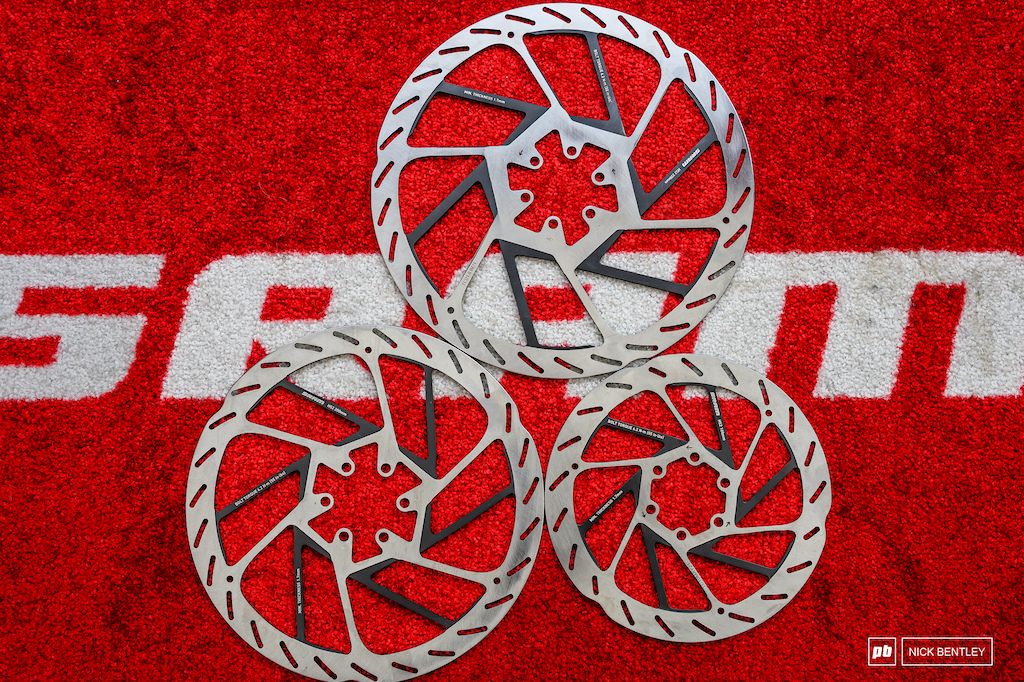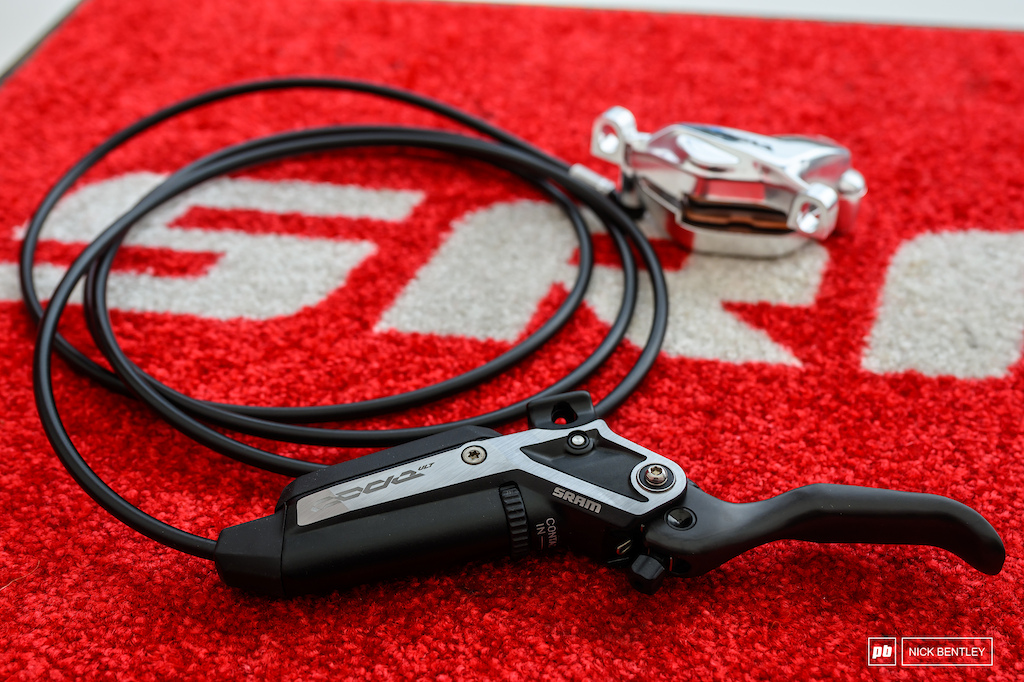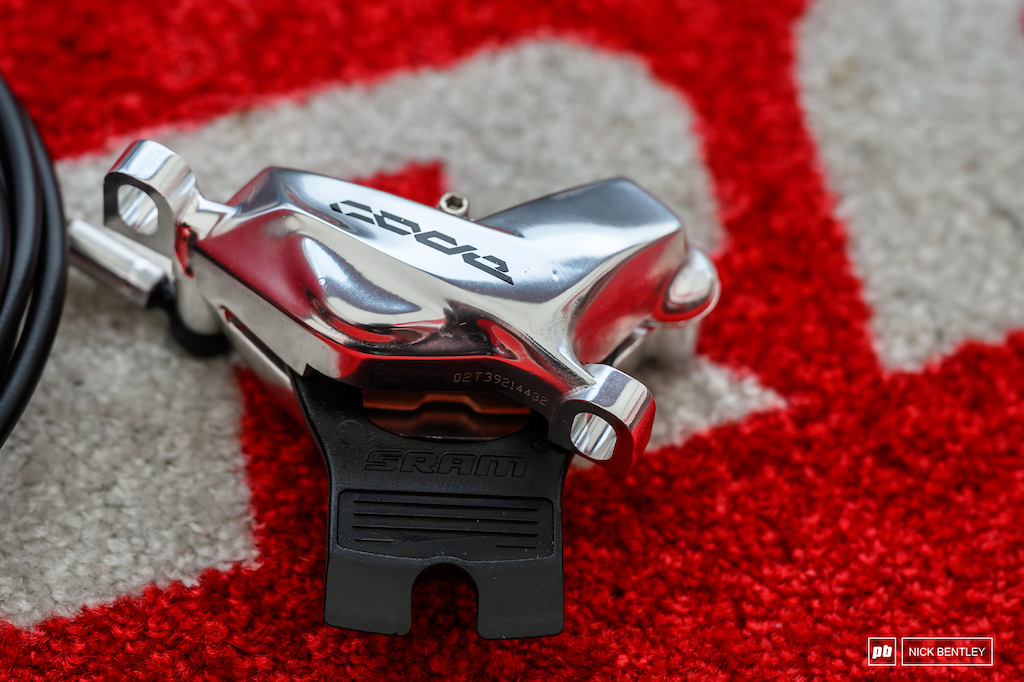Interview: World Cup DH Brake Tech with SRAM
In part two of our World Cup tech interviews, we stopped by to chat with SRAM. If you have ever been to a World Cup before you will have seen the massive SRAM service truck in the pits helping keep UCI elite teams and privateers going throughout the race weekend.
I spoke to Evan Warner who was right in the middle of a Boxxer fork service (sorry about that Evan). Evan is the man to speak to when it comes to SRAM service at a World Cup. It was good to hear what he had to say about how they keep the world's fastest riders running at their best.
 Have you seen any big changes the riders are making to their brakes here at Val Di Sole?
Have you seen any big changes the riders are making to their brakes here at Val Di Sole?
Yeah, we're just getting into elite practices, and we did the junior practice yesterday. Over the years, we typically expected Val Di Sole to be the most brake-intensive track of the series. So yeah, this track definitely stands out. Typically, it feels really hot here. That's one reason it's very steep and very fast. There's always dust everywhere too. It's kind of like a perfect trifecta storm of all the stuff brakes hate. So we usually come here and tend to find that all the downhill athletes are going up a rotor size. But generally, fresh pads and rotors for this round are pretty key.
 Do you see a lot of brake pad compound changes too?
Do you see a lot of brake pad compound changes too?
Not typically, although I shouldn't say typically as it changes from rider to rider. But I would just say we start fresh mostly. If we can start off the weekend on the good foot, like with fresh pads and rotor, we are in a good place.
 Has this intensive block of racing changed the issues you're seeing?
Has this intensive block of racing changed the issues you're seeing?
Yeah, for sure. We have had an intensive block with 3 World Cup races close together and Crankworx in between. The people who didn't go to Crankworx may have gone to Schladming or Morzine, which are also tough on brakes. So we have done a lot of brake bleeds and just flushed some new fluid in there, starting fresh from there. It's a lot like what we do for suspension where we do a lower service and stuff at the beginning of the week. We tend to do the same here for brakes. We use new rotors and give a good flush of brake fluid. It's just as much as you can do to get your bike working well before you start practice. That's why we were very busy during track walk yesterday.
 What's the most common kind of issue you see here at the World Cup?
What's the most common kind of issue you see here at the World Cup?
It's a lot of simple stuff, like that guy who just came in. He changed pads but did not change his rotors, so he needs to go and do that too. It's all about getting to the fresh starting point like I said. I think a lot of times, we see some setup issues more from the privateer side. It's not on purpose, but maybe they didn't have the right bolts or the right adapter. Even just the most basic things like, I went from a 200 to a 220, I didn't have the right adapter. So I tried to bodge it with this 203 adapter, and now I'm not getting full contact. So even just the setup stuff, I mean, obviously not with the pro elite teams, but in terms of a privateer aspect, just the basic setup of like, oh, I had this 203 rotor, I'm trying to use it on a 200 post mount. Stuff like that, we're like, well, that's not gonna work. Ideally, having spare parts and the necessary parts to start fresh, as we were saying, is key. Because it's the one thing that as a rider, as an athlete, pro team or privateer, you can't control your bike, you can't control the weather, you can't control the track, but you can at least show up with your bike working right. I think the key here is just starting off really good and fresh.
 What do you think is the key to getting brakes perfect for World Cup racing?
What do you think is the key to getting brakes perfect for World Cup racing?
For me, it's knowing your setup, having spent time playing with the reach, playing with the pad contact, even trying pads that you may not like, such as organic versus metallic pads. Understanding the power differences between the 203 rotor and 220 rotor, having all that figured out before you show up here. Because, again, we don't think of brakes as suspension that you can tweak and change, but you can. It's good to know what a 200mm front rotor and 220mm front rotor feel like or what an organic set of pads does and what a metallic set of pads does. Do your homework and know the pros and cons.
 What's your advice to your average rider who wants to set their brakes up better?
What's your advice to your average rider who wants to set their brakes up better?
I think for me, typically, it's just general maintenance. Brakes aren't necessarily something that you can set and forget forever. I think regularly bleeding brakes helps so much as well, especially at this level. I'm not trying to say overdo it, but definitely don't let your pads wear down too much. Like the poor little guy who just came in. His rotor was just glazed over because his pads were worn. It's just paying attention to things like that, that helps keep contamination at bay. Also, be conscious that you don't want to spray a lot of stuff when you wash the bike. That's a big one. I make that mistake, but it's something to be even more conscious of at this level. You don't have a lot of practice time, so you have to maximize it. You're not going to do yourself a favor if you contaminate your brakes by not cleaning them right and cost yourself track time. So, just think of the brakes a bit like suspension at home, where it needs some maintenance and attention to detail.
After seeing the guys at SRAM, I headed round to the Trek pits and had a chat with Reece Wilson about his brake set up.
 So Reece, do have any kind of must haves when it comes to your brake set up?
So Reece, do have any kind of must haves when it comes to your brake set up?
I am fairly particular with brakes set-up but mostly I would say how in board I run the lever, so the actual lever and blade. If you look at the front of the bike, its close to grip and into the stem than most people. I never really thought about it being for leverage but I guess that's one of the benefits of having it there. You get a little bit more leverage on the end of the lever as well as not having to squeeze as hard I guess is that is outcome of that. I think I do just because I've got really big hands though for being a reasonably small guy and I think that I just like them having my fingers turned inwards a little bit and it just feels nice on my wrists and elbows. So yeah, that's the one thing that I'm super tight on.
 Do you have a big pull on your brake lever?
Do you have a big pull on your brake lever?
I have a very short pull. Yeah, again I don't know. That's not something I really thought about in order to have the setup but now that I've had the set up since the start of me riding mountain bikes, I guess the way I look at it now is the closer your hands are to being a full fist, the stronger you are. You know, so I like to run the levers pretty close to the grip. The downside to that can be if your brakes fade, then you don't have any room, so I guess it's a bit of a high risk set up but luckily for us having mechanics to work on the bike every single run, it's not too risky. Also these new brakes with thicker rotors, actually SRAM brought us a new two millimetre thick rotor now, and that just disperses a lot more heat and gives you a lot more consistency with the brake feel and it doesn't fade as much, so that has meant my brake setup is working pretty well now.
 What diameter rotor size are you running?
What diameter rotor size are you running?
I'm running 220mm rotors right now. As soon as the 220mm rotors came out I wanted them, as they help keep the least amount of heat you can have in the rotor as possible.
 If there's one piece of advice you would give to people about dealing with their brakes, what would it be?
If there's one piece of advice you would give to people about dealing with their brakes, what would it be?
For me it's getting the pad as close to the disc as humanly possible, so that you allow yourself as much wear without the lever changing too much. So if you have a lot of, what I guess some people call it a free float, cutting that down and having the lever as sharp as possible so the bite is almost instantaneous and that gives the brake just a really solid feel. So that's one thing to amateurs I would say try and get that pad as close to the disc as you can get it without it rubbing and you're going to get a much more solid brake feel. Some people will go against that. I think there's tests being done now with the brake sensors being brought out, it says that people drag the brake but I think there's a difference between that sense of being engaged because the levers move, then you actually applying forces. Us athletes are pretty good at braking and you kind of know when you're braking even if it's a fine drag you probably want to.
 Here is probably the most challenging place all year on brakes traditionally, do you do anything different for here brake wise?
Here is probably the most challenging place all year on brakes traditionally, do you do anything different for here brake wise?
Not really no, like I said our brakes are pretty solid now. It's been a long time since we've had a complaint about a brake at a race. So no I don't do anything I set and forget with the brakes levers staying where they are. I'll click them here and there and maybe move them up and down on the bar ever so slightly depending if we are fitting new bars and maybe just a little bar roll here or there, I’m not overly particular with that I will sit and faff with it, but now they're solid.
In part 3 of our dive into brake tech at the DH World Cup, we will speak to the guys at TRP about their brakes.






My experience with people hating on codes is bad maintenance.
I contacted Magura and they sent replacement parts from the US to Canada the next day. Received in maybe 3-4 days max. They could have sent a new MC lever assembly, but they send an entire brake! Can't complain about their parts/service over here. Gold service.
It’s a pain but makes for great brakes!
After the alcohol-swabbing clean vs dot fluid I got no more stuck or uneven push / retratction - just nice even push / return - and no more occassaional contamination. At least - seemed to work better for me. Have either of you guys heard or tried this and/or think maybe that's not the jam?
For some people 20-25 hours might be a month…maybe even 2?
I'm not a master mechanica but after doing the alcohol cleaning only, I seemed to get better piston extraction / retratction and no more 1/2 emerged pistons - very even pistons on each side. Kinda feeling out if anyone else has done this - the alcohol only vs. applying oil was new to me so trying that seemed interesting...
Check it out: crest-tool.com
1. Set Contact point to a couple turns from all the way in (maximum free float)
2. Remove wheels and squeeze levers so pads touch. Then squeeze more. If your pads are very worn maybe don't have contact adjuster all the way in.
3. Pry apart pads, reinstall wheels/rotors.
3. Perform a normal bleed.
4. Now you just "zeroed" the adjuster with the pads against the rotos and you have the whole contact adjustment range as your pads wear to keep the pads right against the rotor. In other words now the contact adjuster improves bite point, not worsens it.
If the pads are too tight against the rotor when done, this is why you left a couple turns of free float in step 1.
Just open the bleed port with syringe attached and add some pressure/fluid, then close the bleed port while maintaining pressure on the syringe. Be warned though. If you ramp up the presure too much and add too much fluid, if you hit a long decent and heat builds in the system, the pads may end up rubbing on your rotor.
It's trial and error to find the sweet spot. I worked this method out for myself but have since found it mentioned elsewhere. I'm sure there was a youtube video that showed it(no idea who) and also heard Lyle, Greg Minaars mechanic mention it in a video somewhere.
Hope that helps
“Make sure you’ve got the contact point wound fully out (opposite direction to the arrow) bleed the brake as normal then fit the pads and put the wheel in, squeeze the lever (with the syringe still attached) until she’s biting then finish the bleed as normal at the lever. You don’t end up with much space to play with between the pad and rotor so make straight rotors are important”
“If you want even more touch take a look at the thickness of your rotors and find some thinner ones to bleed with. The 220’s we use are 2mm wide and I have some 1.8mm wide rotors to bleed with. When fitting the 2mm’s back in that reduces the lever throw further“
SRAMs stated reason for not using this technique is that it slightly increases volume in the system, which can be a problem as moisture enters the system and expands. The people suggesting to overfill the system are making the same risk, though I don't think it's too risky in my experience.
If you just do the overfill method you can't adjust for pad wear using the contact adjustment. If you use my stated method you can adjust for that as the pad wears.
they f*cking suck, straight from the factory. as a guy that has maybe a legit hundred sets under my belt....they just suck in comparision to Shimano, Magura, TRP.
I do think the piston seals drying out is a bit of an overblown concern, rubber formulations have gotten so much better and as you say the seal is still lubricated from the backside. Plus iso alcohol is a lot less corrosive than the DOT fluid that the seals are designed to handle and since you dry the whole thing with compressed air before pushing the piston back in it's really only in contact for a minute or two.
Since I started only cleaning with alcohol and no DOT fluid I'm only servicing my brakes once or twice a season vs. regularly with dealing with sticky pistons before.
Part of it is the Dominion bleed has 3 ports and allows you to get a SERIOUSLY firm bleed every single time. A normal bleed just can’t get all the air out of the calipers. But Dominions have two ports on caliper so you just bleed the caliper last and it’s great.
Also, getting the calipers centered and the pistons extending and retracting evenly made a substantial difference. Have to play around with them during brake bleed, but this was helpful I thought: youtu.be/AY80Zt47M3A
The only ones telling you to do this are the ones seeling the rotos.
In my collection of anecdotal evidence even changing compounds without cleaning has never had adverse effects.
I myself have never had an issue swapping compunds, I have never heard about anyone actually having issues and there even is a video of Remy Gauvin swapping compounds every run to figure out whats faster.
When changing my pads I usually clean the rotors for good measure, but Ive also skipped it plenty of times.
I would be much more inclined to believe the manufacturers, even though Ive never experienced the problem, if they backed it up with some actual facts and explainations. To me it just sounds like a lazy blanket statement to cover their ass for some 1 ppm failiure and sell a few more rotors along the way.
Thoughts on how any of you do this?
Also new pads help as well as braking style, if you have strong brakes you tend to trust them pulling them hard as and when you need, weak brakes tends to make the rider drag brakes more.
If you have the RS or RSC it's worth noting the cam in the lever gives more leverage (power) as you pull further into the stroke.
A sweet running brake lasts a long time and its normally a day of biking steep/new trails in the wet that meant you dragged more and the pads got contaminated causing issues again. A bleed and pad refresh is usually enough to return them back to their best.
If your keen to save money a good clean and sandpaper of the pads followed by a good bed in can work.
I've gone back to following SRAM guidance and have perfect brakes
And ditto on all the tips, have been sanding / rebedding every brake pad set and even sometimes 1/2 through a set (even flipping pads around every few rides though again - no clue that actually does anything. Mostly tend to avoid riding at all in very wet or rainy conditions except for passing through seepage areas or shallow creeks...not a fan of major bike cleanup but I imagine that could help eff up pads / pistons even with a little bit.
Just curious - I'm sure you have wetter conditions in yr area but how often are you finding a bleed necessary?
I stored my bike vertically and it was fine, upsidedown is only an issue if you have air in the system.
I find I can go 18months if I have a good bleed and run of riding conditions, if I go through riding in torrential conditions (like last weekend) a bleed/decontamination/re bed will likely be required, even after that it often takes 2 or 3 bleeds in short succession to get them perfect. Typically that happens 1/2 times over winter, I rarely touch the brakes over a summer unless bad weather at a bike park happens
How exactly do simply "worn" pads cause glazing? Worn _out_, all the way to the backing? Maybe. Dirty? Maybe. But just worn some? Not really a cause of glazing.
Thank you
Huh so in other words ditch your Code’s for some TRP’s.
us.muc-off.com/collections/bicycle-protection/products/disc-brake-covers-bolt
One of the brake sets was bought used on pinkbike with rusty looking screws. Works even better than the fresh pair that came stock on my other bike
There was the warranty issue with the lever pistons a few years ago. So are you talking about that?
As long as you do the bleed well, it holds for a really long time. Not saying there aren't other gripes with SRAM brakes, but have to disagree with the frequent maintenance complaint
One issue I discovered the hard way with SRAM brakes is the torque of the barrel bolt at the lever. The one that crushes the ferrel thing around the hose end.
The correct torque on that thing is only set with a crows foot wrench and an inch/Lb wrench. And when you get it right, you’d swear your a 1/4 turn into stripping the thing!
Otherwise, you’ll be taking in air forever..
A few helpful tips:
For starters, proper bedding in new brakes is important (If done wrong, sand pads start over or install new set)
Do not cross contaminate by changing pad compounds without new rotors or proper sanding
Toe in and center pads to rotors as perfect as possible
Avoid detergents oils and chain cleaners etc..from soaking into pads when washing
lightly sand pads evenly and occasionally to remove any glazing or contaminates
Reset pistons to reduce lever throw if needed, clean throughly before reinsertion
Maintain a hardy amount of brake pad, swap before too thin
Use Muc-Off Disc brake cleaner to remove grime and recondition pads (Works wonderfully!)
The bedding in part is also especially important - it’s critical on all brakes but especially SRAM ones.
"I would never run them. I'm going off customer feedback and experience."
Other people's bench racing = conclusion.